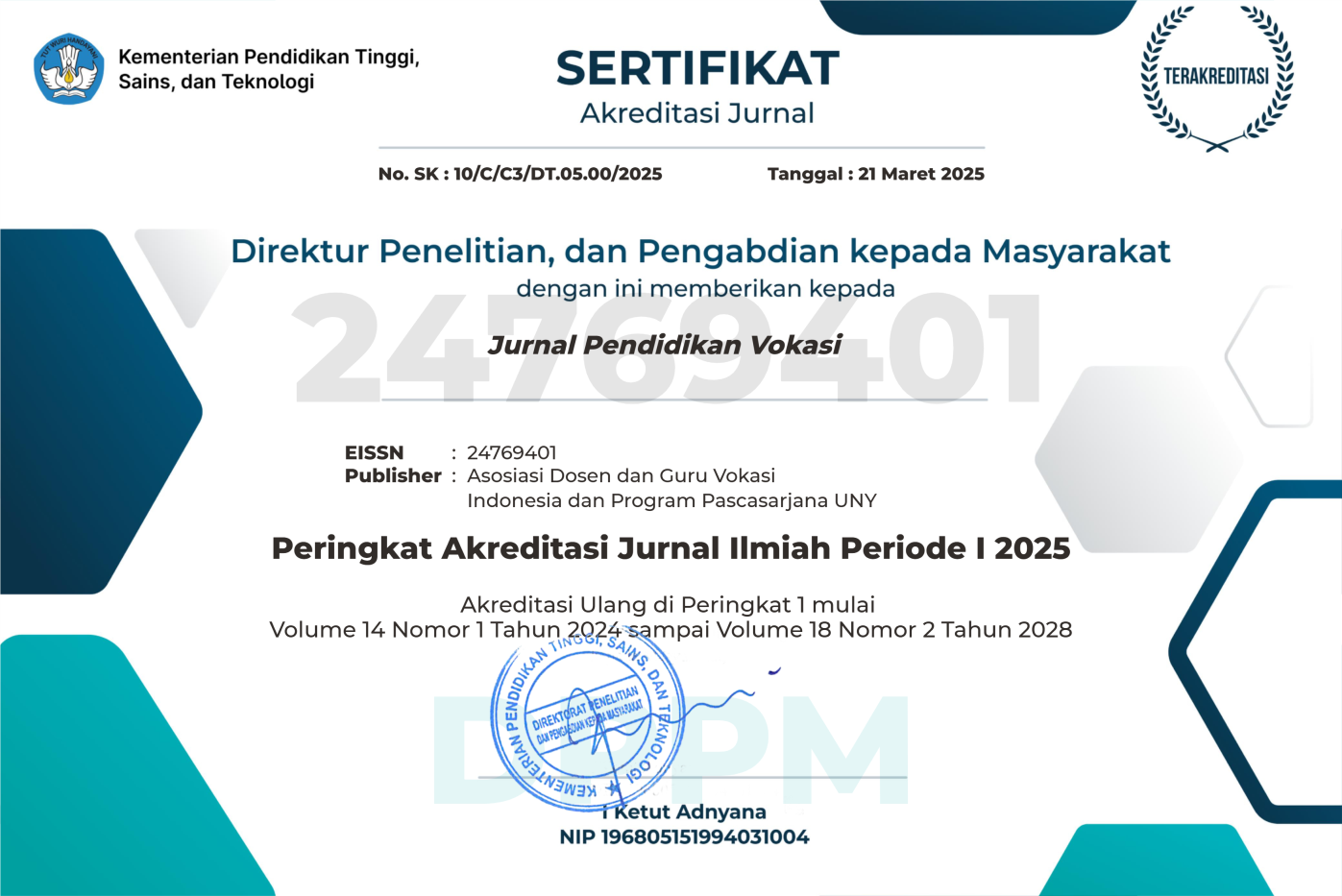Fitur motivasi pembelajran online dengan pendekatan pre-defined set
DOI:
https://doi.org/10.21831/jpv.v2i1.1015Keywords:
e-learning system, the features of motivation, school performance, set pre-definedAbstract
Pembelajaran Elearning dengan memanfaatkan teknologi informasi dan komunikasi berkembang cepat dan dimanfaatkan secara luas. Salah satu permasalahan dalam sistem e-learning, khususnya dalam pembelajaran online adalah peserta didik sering kehilangan motivasi. Fitur motivasi adalah fitur himpunan kalimat motivasi yang dikembangkan berdasarkan 3 indikator kalimat motivasi. Strategi implementasi yang digunakan adalah pre-defined set yaitu pemberian motivasi ditentukan berdasarkan pilihan sendiri. Ekperimen ini menggunakan subjek 68 mahasiswa dibagi menjadi 2, yaitu kelompok eksperimen dan kelompok kontrol. Hasil analisis N-gain menunjukkan bahwa ada peningkatan prestasi belajar pada kelompok pre-defined set dengan kategori peningkatan sedang (g = 0,537), dan peningkatan prestasi belajar pada kelompok kontrol dengan kategori peningkatan sedang (g = 0,399). Sedangkan dari hasil t-test didapatkan beda yang signifikan antara kelompok kontrol dan kelompok predefined set dengan t-hitung = 2,279 dan t-tabel = 1, 980 (tingkat kesalahan 5%). Kesimpulan dari penelitian ini adalah: 1) Hasil ujicoba menunjukkan bahwa fitur motivasi yang dikembangkan dengan pendekatan pre-defined set lebih efektif dalam meningkatkan prestasi belajar dibanding dengan konvensional.
MOTIVATION FITUR ON THE ONLINE LEARNING BY PRE-DEFINED SET APPROACH
Abstract
E-Learning develops fast and widely implemented in learning, especially for online learning. One of problems on e-learning is unmotivated learning students. Motivation fitur is a set of motivation sentences deveveloped based on three indicators of motivation sentences. Pre-defined-set approach was used to develop based on selffote system. Subject for this experiment was 68 students that diveided into two groups: exeperiment and controll. The result of N-gain analysis showed that student achievement increase with g = 0,537, and g=0,399 for controll group. While t-test analysis showed that there is a significant different in effectiveness between group of pre-defined set and controll group with t= 2,279 at 0.5% significant level. The findings of this research are: (1) the pre-defined- set approach generate a higher motivation on learning than convensional.
References
Code, J. R., Allister, K. M., Gress, C. L. Z., & Nesbit, J. C. (2006). Self-Regulated Learning, Motivation, and Goal Theory: Implications for Instructional Design and E-Learning. Proceedings of the Sixth International Conference on Advanced Learning Technologies (ICALT'06).
Dietrich, J. (2003). E-learning decision making. Independent research project in applied mathematics, Systems Analysis Laboratory, Helsinki University of Technology.
EduTools A. (2004). Product Information. Diakses pada tanggal 8 September 2004 dari http://www.edutools.com/course/productinfo.
Grizzell, J. (2003). Behavior Change Theories and Models. American College Health Association.
Hake, R. R. (1998). Interactive-engagement versus traditional methods: A six-thousand-student survey of mechanics test data for introductory physics courses. American Journal of Physics, Vol. 66, No. 11, January 1998.
Huitt, W. (2001). Motivation to learn: An overview. Educational Psychology Interactive. Diakses dari http://chiron.valdosta.edu/whuitt/col/motivation/motivate.html pada tanggal 11 Mei 2008.
Maya, C. (2001). Factors Affecting the Achievement Motivation of High School Students in Maine. University of Southern Maine.
Mazza, R. (2004). Using Information Visualization to Facilitate Instructors in Web-based Distance Learning. Disertasi program doktor di Faculty of Communication Sciences, University of Lugano.
Renchler, R. (2002). Student Motivation, School Culture, and Academic Achievement. University of Oregon.
Robson, R. (2003). The Global Framework for E-Learning. Simon Fraser University. Diakses dari http://www.colab.sfu/events/2003sep25.html pada tanggal 20 Maret 2004.
Scherer, J. B. M., Rich, R. E., Scherer, C. W., & Nunn, S. M. (2002). Technology in Organizational Learning: Using High Tech for High Touch. Journal of Educational Technology & Society, Vol. 5 Number. 2, pp 87-92.
Simons, J. A., Irwin, D. B., & Drinnien, B. A. (2008). Maslow's Hierarchy of Needs. West Publishing Company, New York, 1987. Diakses dari http://honolulu.hawaii.edu/intranet/committees/FacDevCom/guidebk/teachtip/maslow.htm pada tanggal 17 September 2008.
Sugiyono (2008). Metode Penelitian Kuantitatif, Kualitatif dan R&D. Alfabeta. Bandung.
Zenzen, T. G. (2002). Achievement Motivation. Research Paper Master of Science Degree Industrial/Technology Education. University of Wisconsin.
Downloads
Published
How to Cite
Issue
Section
Citation Check
License
The authors submitting a manuscript to this journal agree that, if accepted for publication, copyright publishing of the submission shall be assigned to Jurnal Pendidikan Vokasi. However, even though the journal asks for a copyright transfer, the authors retain (or are granted back) significant scholarly rights.
The copyright transfer agreement form can be downloaded here: [JPV Copyright Transfer Agreement Form]
The copyright form should be signed originally and sent to the Editorial Office through email to jpvokasi@uny.ac.id
Jurnal Pendidikan Vokasi by http://journal.uny.ac.id/index.php/jpv is licensed under a Creative Commons Attribution-ShareAlike 4.0 International License.












